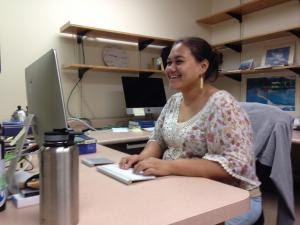By Staff Reports
(Oahu)– Jennifer Wong-Ala, a 2017 spring graduate from the University of Hawai‘i at Mānoa’s Global Environmental Science (GES) degree program, conducted original research to determine how biological and physical factors affect the number of fish surviving to sustain populations of reef fish off West Hawai‘i Island.
Adult reef fish, like yellow tang, release eggs strategically—in places where the eggs can be swept into the open ocean to live out their free-floating larval stage and develop until they are ready to come back to the reef. This process of successfully returning home, termed recruitment, can be influenced by many physical factors including ocean currents, as well as biological strategies such as when and where fish larvae are born and how long the fish remain in the free-floating larval stage.
To explore the influence of these factors, Wong-Ala and her mentor, oceanography assistant professor Anna Neuheimer, developed a computer model that accounted for date of birth, location of birth, movement of larvae, duration of the free-floating larval stage, development, settlement and death of larval reef fish off of Hawai’i Island.
Their study found that recruitment changed depending on the fish’s birthdate due to influences of the currents, eddies and moon phase (i.e. tides). Additionally, location of birth mattered, with individuals born in shallow and sheltered bays having higher rates of recruitment compared to individuals born in unsheltered locations under certain conditions.
“This study provides a baseline understanding of how biophysical factors interact to impact recruitment in western Hawai‘i Island,” said Wong-Ala.
The information can be used to explain species-specific variation in recruitment from year to year and predict possible changes in the future. Understanding the amount of fish that make it back to the reef is important for maintaining sustainable reef fish populations.
“I chose GES because it is an interdisciplinary major that allows us to learn about the changes in the environment, gain valuable computer skills, and focus on what we are truly interested [in],” said Wong-Ala, who was born and raised in Waimānalo on Oʻahu. “My favorite aspect of my thesis experience is the relationship that developed with my mentor. I have worked in her lab for three years and it has been an experience that has taught me so much. I hope to be a mentor like her in the future.”
A graduate of Kapiʻolani Community College (KCC), Wong-Ala became interested in environmental science through the KCC-SOEST summer bridge program. She was invited to participate in SOEST Maile Mentoring Bridge (‘Maile’), a program that strives to recruit and retain Native Hawaiian and kama’āina undergraduates in ocean, earth and environmental science degree programs at SOEST. Anela Choy, Wong-Ala’s mentor, co-founded the Maile program along with Barbara Bruno and Keolani Noa. The program helps student thrive through individualized mentoring and peer support.
Having graduated on May 13, Wong-Ala is preparing to enter a graduate program at Oregon State University in Ocean, Earth and Atmospheric Sciences.
The GES program at the UHM School of Ocean and Earth Science and Technology (SOEST) trains high-quality students to be knowledgeable in Earth-system science and think creatively about the challenges facing communities and natural resources now and in the future. As a GES degree requirement, each student performs original scientific research, writes a research thesis and presents findings publically. Mentors include SOEST faculty – global leaders in the fields of ocean, earth and space science, as well as technology. Throughout the GES degree program, students are engaged in fieldwork, laboratory work and field trips, and have access to deep ocean and coastal research vessels, SOEST’s world-class Hawai‘i Institute of Marine Biology, and an active volcano.
Like Us

